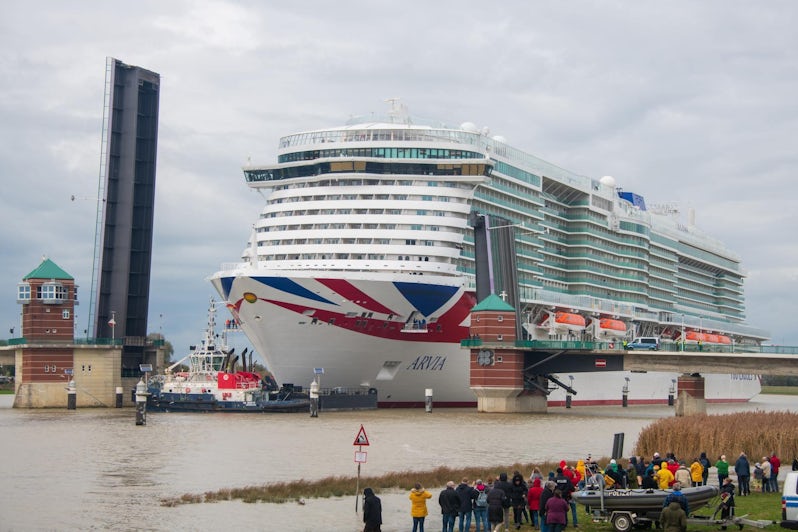
P&O Cruises History: From the 1800s to the Present Day


P&O Cruises dates its origins back to 1837, making it the oldest cruise line in the world, and certainly one of the most famous.
Though a British line through and through, carrying and catering almost exclusively to Brits, it is ultimately owned by a huge U.S. company, Carnival Corp., which also owns sister brands Princess Cruises and Cunard Line, among many others.
From its origins to its current fleet, read on if you're curious to know more about P&O Cruises.
On This Page
Who Owns P&O Cruises?
U.S.-based Carnival Corp., which also owns P&O Cruises Australia, Princess Cruises, Holland America Line and Cunard, among many others, has owned P&O Cruises since 2003.
What Does P&O Stand For in the P&O Cruises' Name?
If you've ever scratched your head wondering what does P&O stand for, we're here to help you out. It's Peninsular & Oriental -- the line's full name when it was founded was the Peninsular & Oriental Steam Navigation Company.
Which Ships Are in the P&O Cruises' Existing Fleet?

Arvia (2022) A sister to Iona, the line's biggest and newest ship launched in December 2022 and divides its time between the UK over the summer and the Caribbean over the winter month. Carrying 5,200 passengers, Arvia features a brand-new for the line high-ropes and mini-golf course along with a swim-up bar infinity pool on the top deck. There are 30 drinking and drinking venues, including a rum distillery, a new escape room, cinema, supper cabaret club.

Iona (2021) The 5,200-passenger ship was the biggest ever purpose-built for the UK market, and is also the line's fist LNG (Liquefied Natural Gas)-powered cruise ship. Iona sails from Southampton year-round to the Norwegian fjords, Spain, Portugal, France and the Canary Islands. Iona debuted the line's SkyDome, a day-to-night leisure-entertainment space, a partnership with Gary Barlow who curates the programme at the 710 Club, a gin distillery and a new cinema complex.

Britannia (2015). Britannia was P&O Cruises' first foray into elegance; the whole ship was designed by a company which specialises in hotel design (Richmond International) and as a result the ship has a luxury hotel feel. Celebrating its 10-year anniversary in 2025, the ship has been one of the most popular among Cruise Critic UK's readers thanks to upmarket feel and emphasis on entertainment and dining.
Azura (2010). Azura continues what Ventura begun, with a wide variety of entertainment, a huge kids' club and large selection of places to eat and drink. Pictured, below, is Azura lit up with the words "We'll Meet Agaian", during the Covid-19 pandemic.

Ventura (2008). The 3,100-passenger Ventura and sister Azura, were specifically designed to break the mould -- bigger, more contemporary and family-friendly, this ship marked a step-change in terms of size and design for the line.
Arcadia (2005). Arcadia is one of two adult's only ships. It's also the only one not ordered by P&O Cruises -- it was originally destined for Holland America Line and then Cunard, to sail as Queen Victoria.
Aurora (2000). Aurora is the oldest ship in the P&O Cruises fleet and also one of the line's two adults-only vessels.
History of P&O Cruises
P&O Cruises dates its founding to 1837, making it the oldest cruise line in the world. However, its origins date back even further -- to 1822, when the Peninsular Steam Navigation Company was founded by two men, a London shipbroker by the name of Brodhie McGhie Wilcox (after whom the Brodie's pub on many of the modern P&O ships is named); and a Scottish sailor, Arthur Anderson. On August 22, 1837, they won a government contract to deliver mail from the U.K. to the Iberian Peninsula, and this is the date the company traditionally regards as its foundation date. However, it was not until 1844 the line carried its first passengers -- to Athens, Gibraltar and Malta, sailing, as it still does, from Southampton, U.K.
These first journeys are now recognized as the origins of what we regard as a cruise today, though the ships were still used primarily as a means of transport rather than a "pleasure cruise."
In 1840 the line merged with the Transatlantic Steam Navigation Company, after which the company became known as the Peninsular and Oriental Steam Navigation Company -- or P&O for short.
In 1882 a new chairman, Thomas Sutherland, presided over a huge building programme, begun 10 years earlier, which focused on speed, efficiency and greater capacity for freight and passengers. In the course of the decade, 29 new ships were launched beginning with Ravenna, the first company vessel to be built of steel. And a new class emerged, the 6,000-ton, four-strong, Jubilee Class -- Victoria, Britannia, Arcadia and Oceana -- whose names live on in today's fleet.
P&O Cruises Enters the Cruise Business
The turn of the century saw a dip in the traditional trade routes and a need to utilize many of the fleet in alternative ways. And in 1904 the line entered the business of "pleasure cruises" for the first time. To start this new service, the line refitted a laid-up mail steamer, the 6,000-ton Rome, as a "cruising yacht" and renamed it Vectis. It carried just 150 passengers and offered cruises to the Mediterranean. Ten years later, Sutherland negotiated a merger with British India Steam Navigation, bringing its fleet to 197. A few months later, two-thirds of that fleet was commandeered for service in the First World War.
A month after the end of the war, in December 1918, P&O bought 51 percent of Orient Steam Navigation Company, and by 1924 P&O had become the largest shipping company in the world. The 1930s proved a tough period, forcing the line to introduce a "tourist class" to appeal to a growing number of cash-conscious cruisers. The Second World War saw half the fleet destroyed or damaged and, postwar, a radical rethinking of the line's direction.
When cruising resumed in the early 1950s, P&O was first off the blocks with transport to Australia, carrying the "ten pound poms" (tourists) in their thousands Down Under. Such was the demand, the line commissioned two brand-new ships in 1955, Canberra and Oriana -- its last passenger liners, which brought the journey time to Australia down to just three weeks. In 1960 the line bought the remaining stake in Orient Lines and renamed itself P&O-Orient Lines.
The Modern P&O Cruises Era Begins

In 1974 the line bought Princess Cruises; three years later it created P&O Cruises Australia. In February 1979 Sea Princess began operating out of Australia, replacing Arcadia.
Three years later, Oriana replaced Sea Princess which re-deployed to the U.K. That same year, another P&O cruise ship was forced into battle -- this time Canberra in the Falklands War. When Canberra returned, Sea Princess then moved to the Princess fleet and the U.K. was left with just one ship serving it. Mindful that Canberra would soon have to be retired, P&O ordered a new Oriana in 1995, which still sails as the oldest ship in the P&O Cruises' fleet. Aurora joined the fleet in 2000; followed by Oceana, which originally sailed as Ocean Princess under the Princess brand. Adonia entered service in 2001, far and away the smallest of the fleet holding just 710 passengers and measuring 30,000 tons. It operated briefly as Fathom Adonia in 2016/17, and will leave the fleet in 2018 to become Azamara Pursuit.
In 2003 Carnival Corp. acquired ownership of the line, creating two separate brands: Princess Cruises and P&O Cruises Australia.
Arcadia joined the fleet in 2003 after a circuitous route -- originally intended for Holland America Line, transferred to Cunard Line to be Queen Victoria, it transferred to P&O during construction. There followed the 3,080-passenger Ventura in 2008; a sister, Azura two years later; and then the largest ship ever built specifically for the U.K. market, Britannia in 2015.
In 2021 (one year delayed because of the pandemic), the 180,000-ton, 5,200-passenger Iona launched; followed by a sister ship, Arvia, in December 2022.